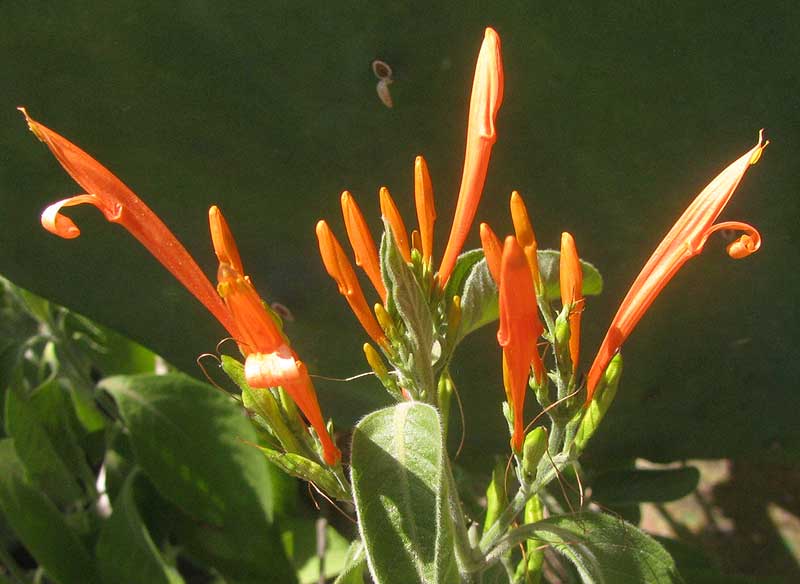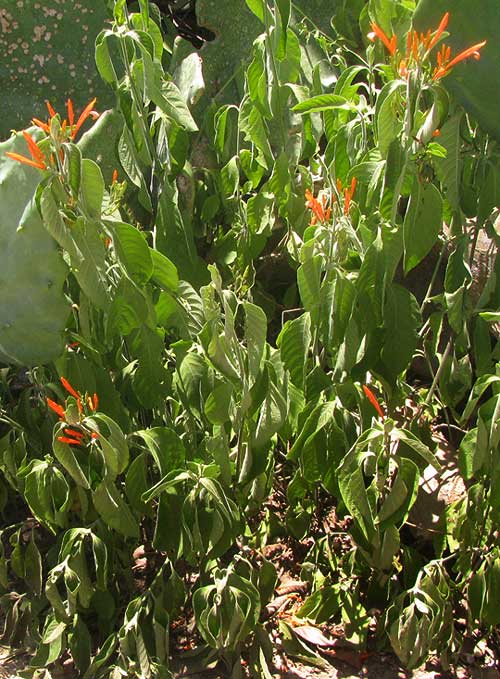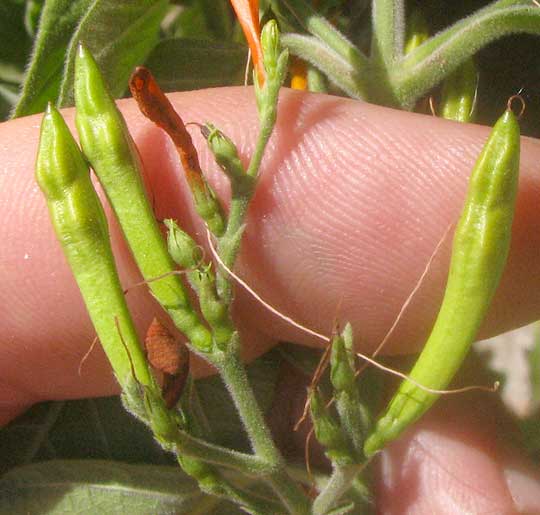Excerpts from Jim Conrad's
Naturalist Newsletter

from the July 27, 2014 Newsletter issued from the Frio Canyon Nature Education Center in the valley of the Dry Frio River in northern Uvalde County, southwestern Texas, on the southern border of the Edwards Plateau; elevation ~1750m (~5750 ft); N29.62°, W99.86°; USA
MEXICAN HONEYSUCKLE
Last week we looked at a big Indian-Fig Pricklypear, or Nopal Cactus, planted along a sidewalk on a backstreet in Uvalde. Below the big cactus there grew the red-flower plant
-- reasonably wilting in tremendous heat and sunlight -- pictured below:

Up close, the blossoms displayed a distinctive, bilaterally symmetrical, two-lipped design, the top lip straight and projecting forward while the lower lip tightly curled under. Once pollenated, the corollas fall off leaving the ovary -- the future fruit -- atop which the long, slender, dark, wiry style remains bending this way and that, adding a curiously unkempt feature to the pretty head, as shown at the top of this page.
We've seen this pretty plant often in many places in Mexico and, as with the Indian-Fig Cactus, or Nopal, I was surprised to see it doing so well in Uvalde. In English it's known mostly as Mexican Honeysuckle, though it's in a completely different family from real honeysuckles. It's also called Firecracker Bush, Orange Plume Flower, Desert Honeysuckle and other names. It's JUSTICIA SPICIGERA, a member of the Acanthus Family, the Acanthaceae, and it's recognized as a prolific nectar provider, especially for hummingbirds.
Our Mexican Honeysuckle in Uvalde already had some ovaries mature enough to show one of the neatest field marks for the Acanthus Family, which is that the mature fruits in the family nearly always display the general shape of upside-down violins -- the broad part at the top, while below the narrower "neck" arises from the green calyx, as shown below:

Those wiry styles hanging onto the ovaries longer than it seems they should also often serves as a good field mark for members of this family.
Mexican Honeysuckle is native throughout most of Mexico south to Costa Rica, plus often it graces gardens throughout much of the tropical world. In Uvalde it looked like it was growing "wild" as a weed around the cactus, but I guess it was planted, since it's not listed for Texas, though apparently sometimes it escapes and persists in southern Florida.
In Mexico, Mexican Honeysuckle has often been used in traditional medicine, the leaves being used against dysentery, and even today backwoods curanderos serve a tea brewed from its leaves for dengue and heart problems, and somehow use the fruits for coughs and asthma. In fact, a 2012 paper by Ortiz-Andrade et al in the "Journal of Ethnopharmacology" found that extracts from the plant were useful in treating Type 2 diabetes because it stimulates the uptake of glucose under various conditions.